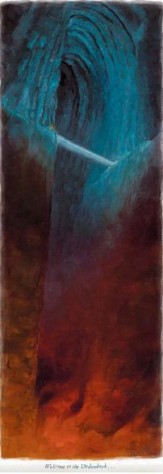7. Grand Canyon of Deepearth

7. Grand Canyon of Deepearth

|
|
|
|
|
|
|
|
|
|
|
|
Geography: This yawning
chasm stretches over ten miles in
length, and is fully a mile
wide. The ceiling of the cavern arches
naturally, and the AREA
has withstood many a tumultuous earthquake
and other natural disaster.
The ceiling is about 200 feet
high at the point where
the tunnel from Area 6 enters. The canyon
walls gradually grow closer
together as they descend. They meet
in a boulder-and-rubble-filled
gorge over a mile below.
The canyon was originally
excavated by water erosion. In fact,
a great river once cut a
path through it. The same shift in water
table that dried up the
duergar wells caused the river to cease
flowing. The canyon is now
similar to a dead cave, except that
few cave formations have
developed. It is not as dusty here as in
some other regions, perhaps
because of the faint breezes
brought by circulating air.
The walls of the canyon
are cracked and riddled with ledges,
chimneys, and other irregularities.
The rock is old, but generally
stable-it is not likely
to break off when climbed. No bridges
cross it at this height.
Across the canyon from the
access tunnel, the cavern continues
to wind into the earth.
About 3,000 feet below this level,
another series of caverns
enters into the canyon on one side and
continues out the other.
These caverns are about two miles south
of the tunnels on the upper
level, so characters scaling straight
down the walls do not discover
them.
The walls of the canyon
are pockmarked regularly with limestone
caves, some of them as deep
as 300 feet. These cave
mouths occur at intervals
of about 500 feet above, below, and to
the sides of each other.
In some cases they are closer together,
and in others more widely
separated.
At the ceiling of the cavern,
several narrow vertical shafts lead
upward to join a major tunnel
that eventually connects with the
sewer system of the large
city on the surface. These tunnels
range from 1-3 feet in diameter,
and often climb straight up, so
they are of little use to
any creatures except bats.
Denizens:
Bats inhabit the canyon in great numbers. Most of
these are of the harmless
normal varieties, but several hundred
mobats also live in the
canyon. The latter subsist off of the former
to a great extent, but the
mobats also aggressively attack any
large warm-blooded canyon
intruders. Fortunately for said
intruders, the mobats do
not attack all together, but in groups of
2d6 at a time.
Several of the small caves
branching off the canyon are the
lairs of cave fishers. These
voracious carnivores attempt to strike
any flying or climbing creatures
that come within their reach. The
bottom of the canyon is
regularly scoured by a pair of giant slugs.
Many of the smaller side
caves are inhabited by giant centipedes,
and carrion crawlers regularly
move up and down the walls.
The only intelligent denizens
are a small group of cloakers living
in one of the highest and
most remote of the side caves. The
cloakers are 50% likely
to be attracted if the mobats attack an
intruder. The cloakers fly
to the combat scene and wait for the
bats to either be driven
off or claim their victim. After the fight, the
cloakers close in and polish
off the wounded intruders or seize a
few of the bats.
The cloaker
community numbers about two dozen individuals.
They do not attack as a
group, however. If an encounter occurs,
balance the number of cloakers
used with the levels of your
PCs.
Resources:
This canyon has a plentiful supply of fresh air
because of all the access
tunnels leading to it. Water is much less
abundant, however; it is
confined to a number of stagnant pools
among the rocks at the bottom
of the canyon. While some of
these pools are very large
and deep, none of them receives any
fresh flowing water. Characters
who drink the water have a 50%
chance of contracting a
disease, as in the cause disease spell
effect. <WSG: Effects
of Drinking Tainted Water>
Food supplies are limited
to the creatures living here and a few
lichens and fungi growing
in narrow niches upon the canyon
walls.